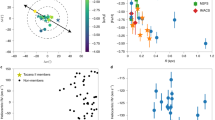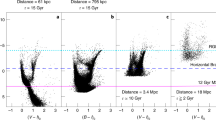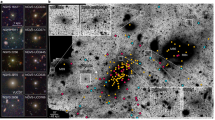Abstract
Our Galaxy is thought to have an active evolutionary history, dominated over the past ten billion years or so by star formation, the accretion of cold gas and, in particular, the merging of clumps of baryonic and dark matter1,2. The stellar halo—the faint, roughly spherical component of the Galaxy—reveals rich ‘fossil’ evidence of these interactions, in the form of stellar streams, substructures and chemically distinct stellar components3,4,5. The effects of interactions with dwarf galaxies on the content and morphology of the Galactic disk are still being explored. Recent studies have identified kinematically distinct stellar substructures and moving groups of stars in our Galaxy, which may have extragalactic origins6,7. There is also mounting evidence that stellar overdensities (regions with greater-than-average stellar density) at the interface between the outer disk and the halo could have been caused by the interaction of a dwarf galaxy with the disk8,9,10. Here we report a spectroscopic analysis of 14 stars from two stellar overdensities, each lying about five kiloparsecs above or below the Galactic plane—locations suggestive of an association with the stellar halo. We find that the chemical compositions of these two groups of stars are almost identical, both within and between these overdensities, and closely match the abundance patterns of stars in the Galactic disk. We conclude that these stars came from the disk, and that the overdensities that they are part of were created by tidal interactions of the disk with passing or merging dwarf galaxies11,12.
This is a preview of subscription content, access via your institution
Access options
Access Nature and 54 other Nature Portfolio journals
Get Nature+, our best-value online-access subscription
$29.99 / 30 days
cancel any time
Subscribe to this journal
Receive 51 print issues and online access
$199.00 per year
only $3.90 per issue
Buy this article
- Purchase on Springer Link
- Instant access to full article PDF
Prices may be subject to local taxes which are calculated during checkout



Similar content being viewed by others
References
Freeman, K. & Bland-Hawthorn, J. The new galaxy: signatures of its formation. Annu. Rev. Astron. Astrophys. 40, 487–537 (2002)
Bullock, J. S. & Johnston, K. V. Tracing galaxy formation with stellar halos. I. Methods. Astrophys. J. 635, 931–949 (2005)
Helmi, A., White, S. D. M., de Zeeuw, P. T. & Zhao, H. Debris streams in the solar neighbourhood as relicts from the formation of the Milky Way. Nature 402, 53–55 (1999)
Bell, E. F. et al. The accretion origin of the Milky Way’s stellar halo. Astrophys. J. 680, 295–311 (2008)
Nissen, P. E. & Schuster, W. J. Two distinct halo populations in the solar neighborhood. Evidence from stellar abundance ratios and kinematics. Astron. Astrophys. 511, L10 (2010)
Helmi, A. et al. Pieces of the puzzle: ancient substructure in the Galactic disc. Mon. Not. R. Astron. Soc. 365, 1309–1323 (2006)
Stonkute, E., Tautvaišiene˙, G., Nordström, B. & Ženoviene˙, R. Stellar substructures in the solar neighbourhood. I. Kinematic group 3 in the Geneva-Copenhagen survey. Astron. Astrophys. 541, A157 (2012)
Xu, Y. et al. Rings and radial waves in the disk of the Milky Way. Astrophys. J. 801, 105 (2015)
Purcell, C. W., Bullock, J. S., Tollerud, E. J., Rocha, M. & Chakrabarti, S. The Sagittarius impact as an architect of spirality and outer rings in the Milky Way. Nature 477, 301–303 (2011)
Dorman, C. E. et al. A new approach to detailed structural decomposition from the SPLASH and PHAT surveys: kicked-up disk stars in the Andromeda galaxy? Astrophys. J. 779, 103 (2013)
Kazantzidis, S., Bullock, J. S., Zentner, A. R., Kravtsov, A. V. & Moustakas, L. A. Cold dark matter substructure and galactic disks. I. Morphological signatures of hierarchical satellite accretion. Astrophys. J. 688, 254–276 (2008)
Price-Whelan, A. M., Johnston, K. V., Sheffield, A. A., Laporte, C. F. P. & Sesar, B. A reinterpretation of the Triangulum-Andromeda stellar clouds: a population of halo stars kicked out of the Galactic disc. Mon. Not. R. Astron. Soc. 452, 676–685 (2015)
Rocha-Pinto, H. J., Majewski, S. R., Skrutskie, M. F., Crane, J. D. & Patterson, R. J. Exploring halo substructure with giant stars: a diffuse star cloud or tidal debris around the Milky Way in Triangulum-Andromeda. Astrophys. J. 615, 732–737 (2004)
Martin, N. F., Ibata, R. A. & Irwin, M. Galactic halo stellar structures in the Triangulum-Andromeda region. Astrophys. J. 668, L123–L126 (2007)
Sheffield, A. A. et al. Exploring halo substructure with giant stars. XIV. The nature of the Triangulum-Andromeda stellar features. Astrophys. J. 793, 62 (2014)
Sharma, S. et al. Group finding in the stellar halo using M-giants in the Two Micron All Sky Survey: an extended view of the Pisces overdensity? Astrophys. J. 722, 750–759 (2010)
Li, T. S. et al. Exploring halo substructure with giant stars. XV. Discovery of a connection between the Monoceros Ring and the Triangulum-Andromeda overdensity? Astrophys. J. 844, 74 (2017)
Johnston, K. V. et al. Disk heating, galactoseismology, and the formation of stellar halos. Galaxies 5, 3 (2017)
Xue, X. X. et al. The Milky Way’s circular velocity curve to 60 kpc and an estimate of the dark matter halo mass from the kinematics of 2400 SDSS blue horizontal-branch stars. Astrophys. J. 684, 1143–1158 (2008)
Bensby, T., Feltzing, S., Oey, M. S. Exploring the Milky Way stellar disk. A detailed elemental abundance study of 714 F and G dwarf stars in the solar neighbourhood. Astron. Astrophys. 562, A71 (2014)
Magrini, L. et al. The Gaia-ESO survey: radial distribution of abundances in the Galactic disc from open clusters and young-field stars. Astron. Astrophys. 603, A2 (2017)
Yong, D., Carney, B.W., Friel, E.D. Elemental abundance ratios in stars of the outer galactic disk. IV. A new sample of open clusters. Astron. J. 144, 95 (2012)
Feast, M. W., Menzies, J. W., Matsunaga, N. & Whitelock, P. A. Cepheid variables in the flared outer disc of our galaxy. Nature 509, 342–344 (2014)
Kovtyukh, V. et al. The chemical composition of Galactic beat Cepheids. Mon. Not. R. Astron. Soc. 460, 2077–2086 (2016)
Odenkirchen, M., Grebel, E. K., Dehnen, W., Rix, H.-W. & Cudworth, K. M. Kinematic study of the disrupting globular cluster Palomar 5 using VLT spectra. Astron. J. 124, 1497–1510 (2002)
Gratton, R., Sneden, C. & Carretta, E. Abundance variations within globular clusters. Annu. Rev. Astron. Astrophys. 42, 385–440 (2004)
Tolstoy, E., Hill, V. & Tosi, M. Star-formation histories, abundances, and kinematics of dwarf galaxies in the Local Group. Annu. Rev. Astron. Astrophys. 47, 371–425 (2009)
Gómez, F. A. et al. Vertical density waves in the Milky Way disc induced by the Sagittarius dwarf galaxy. Mon. Not. R. Astron. Soc. 429, 159–164 (2013)
Laporte, C. F. P., Johnston, K. V., Gómez, F. A., Garavito-Camargo, N. & Besla, G. The influence of Sagittarius and the Large Magellanic Cloud on the Milky Way galaxy. Preprint at https://arxiv.org/abs/1710.02538 (2017)
Vogt, S. S. et al. HIRES: the high-resolution echelle spectrometer on the Keck 10-m telescope. Proc. SPIE Int. Soc. Opt. Eng. 2198, 362 (1994)
Freudling, W. et al. Automated data reduction workflows for astronomy. The ESO reflex environment. Astron. Astrophys. 559, A96 (2013)
Gustafsson, B. et al. A grid of MARCS model atmospheres for late-type stars. I. Methods and general properties. Astron. Astrophys. 486, 951–970 (2008)
Weck, P. F., Schweitzer, A., Stancil, P. C., Hauschildt, P. H. & Kirby, K. The molecular continuum opacity of 24MgH in cool stellar atmospheres. Astrophys. J. 584, 459–464 (2003)
Ruchti, G. R., Bergemann, M., Serenelli, A., Casagrande, L. & Lind, K. Unveiling systematic biases in the 1D LTE excitation-ionization balance of Fe for FGK stars: a novel approach to determination of stellar parameters. Mon. Not. R. Astron. Soc. 429, 126–134 (2013)
Casagrande, L., Ramirez, I., Melendez, J., Bessell, M., Asplund, M. An absolutely calibrated Teff scale from the infrared flux method. Dwarfs and subgiants. Astron. Astrophys. 512, A54 (2010)
Casagrande, L. et al. Towards stellar effective temperatures and diameters at 1 per cent accuracy for future surveys. Mon. Not. R. Astron. Soc. 439, 2060–2073 (2014)
Kunder, A. et al. The radial velocity experiment (RAVE): fifth data release. Astron. J. 153, 75 (2017)
Lind, K., Bergemann, M. & Asplund, M. Non-LTE line formation of Fe in late-type stars—II. 1D spectroscopic stellar parameters. Mon. Not. R. Astron. Soc. 427, 50–60 (2012)
Valenti, J. A. & Piskunov, N. E. Spectroscopy made easy. A new tool for fitting observations with synthetic spectra. Astron. Astrophys. Suppl. Ser. 118, 595–603 (1996)
Bergemann, M., Collet, R., Amarsi, A.M., Kovalev, M., Ruchti, G., Magic, Z. Non-local thermodynamic equilibrium stellar spectroscopy with 1D and <3D> models. I. Methods and application to magnesium abundances in standard stars. Astrophys. J. 847, 15 (2017)
Bergemann, M., Lind, K., Collet, R., Magic, Z. & Asplund, M. Non-LTE line formation of Fe in late-type stars—I. Standard stars with 1D and <3D> model atmospheres. Mon. Not. R. Astron. Soc. 427, 27–49 (2012)
Storey, P. J. & Zeippen, C. J. Theoretical values for the [Oiii] 5007/4959 line-intensity ratio and homologous cases. Mon. Not. R. Astron. Soc. 312, 813–816 (2000)
Smette, A. et al. Molecfit: a general tool for telluric absorption correction. I. Method and application to ESO instruments. Astron. Astrophys. 576, A77 (2015)
Amarsi, A. M., Asplund, M., Collet, R. & Leenaarts, J. Non-LTE oxygen line formation in 3D hydrodynamic model stellar atmospheres. Mon. Not. R. Astron. Soc. 455, 3735–3751 (2016)
Lemasle, B. et al. VLT/FLAMES spectroscopy of red giant branch stars in the Fornax dwarf spheroidal galaxy. Astron. Astrophys. 572, A88 (2014)
Lind, K., Asplund, M., Barklem, P. S., Belyaev, A. K. Non-LTE calculations for neutral Na in late-type stars using improved atomic data. Astron. Astrophys. 528, A103 (2011)
Bergemann, M. Ionization balance of Ti in the photospheres of the Sun and four late-type stars. Mon. Not. R. Astron. Soc. 413, 2184–2198 (2011)
Korotin, S.A. et al. Grid of theoretical NLTE equivalent widths of four Ba ii lines and barium abundance in cool stars. Astron. Astrophys. 581, A70 (2015)
Villemoes, P., Arnesen, A., Heijkenskjold, F. & Wannstrom, A. Isotope shifts and hyperfine structure of 134–138Ba ii by fast ion beam-laser spectroscopy. J. Phys. B 26, 4289–4299 (1993)
Van Hove, M., Borghs, G., DeBisschop, P. & Silverans, R. E. J-dependent isotope shifts in the 5d2DJ doublet of barium ii. J. Phys. B 15, 1805–1809 (1982)
Silverans, R. E., Borghs, G., de Bisschop, P. & van Hove, M. Hyperfine structure of the 5d 2DJ states in the alkaline-earth Ba ion by fast-ion-beam laser-rf spectroscopy. Phys. Rev. A 33, 2117–2120 (1986)
Lawler, J. E., Wickliffe, M. E., den Hartog, E. A. & Sneden, C. Improved laboratory transition parameters for Eu ii and application to the solar europium elemental and isotopic composition. Astrophys. J. 563, 1075–1088 (2001)
Villemoes, P., Arnesen, A., Heijkenskjold, F., Kastberg, A. & Wannstrom, A. Hyperfine structure measurements of 151,153Eu ii with fast ion beam-laser spectroscopy. Phys. Lett. A 162, 178–181 (1992)
Asplund, M., Grevesse, N., Sauval, A. J. & Scott, P. The chemical composition of the Sun. Annu. Rev. Astron. Astrophys. 47, 481–522 (2009)
Serenelli, A. M., Bergemann, M., Ruchti, G. & Casagrande, L. Bayesian analysis of ages, masses and distances to cool stars with non-LTE spectroscopic parameters. Mon. Not. R. Astron. Soc. 429, 3645–3657 (2013)
Bovy, J. et al. The stellar population structure of the Galactic disk. Astrophys. J. 823, 30 (2016)
Schönrich, R. Galactic rotation and solar motion from stellar kinematics. Mon. Not. R. Astron. Soc. 427, 274–287 (2012)
McWilliam, A. & Smecker-Hane, T. A. in Cosmic Abundances as Records of Stellar Evolution and Nucleosynthesis (eds Randich, S. & Pasquini, L. ) 236–237 (Springer, 2005)
Sbordone, L. et al. The exotic chemical composition of the Sagittarius dwarf spheroidal galaxy. Astron. Astrophys. 465, 815–824 (2007)
Mucciarelli, A. et al. Chemical abundances in the nucleus of the Sagittarius dwarf spheroidal galaxy. Astron. Astrophys. 605, A46 (2017)
Shetrone, M. et al. VLT/UVES abundances in four nearby dwarf spheroidal galaxies. I. Nucleosynthesis and abundance ratios. Astron. J. 125, 684–706 (2003)
Kirby, E. N. et al. Multi-element abundance measurements from medium-resolution spectra. II. Catalog of stars in Milky Way dwarf satellite galaxies. Astrophys. J. Suppl. Ser. 191, 352–375 (2010)
Letarte, B. et al. A high-resolution VLT/FLAMES study of individual stars in the centre of the Fornax dwarf spheroidal galaxy. Astron. Astrophys. 523, A17 (2010)
Cohen, J. G. & Melendez, J. Abundances in a large sample of stars in M3 and M13. Astron. J. 129, 303–329 (2005)
Ramírez, S. V. & Cohen, J. G. Abundances in stars from the red giant branch tip to near the main-sequence turnoff in M71. III. Abundance ratios. Astron. J. 123, 3277–3297 (2002)
Acknowledgements
We thank I. Georgiev for help with the telluric correction of the stellar spectrum taken with the UVES spectrograph at the VLT. A.M.S. was supported by grants ESP2015-66134-R and ESP2017-82674-R (MINECO). K.V.J.’s contributions were supported by a grant from the National Science Foundation (AST-1614743). L.C. acknowledges support from the Australian Research Council (grants DP150100250 and FT160100402). Parts of this research were conducted by the Australian Research Council Centre of Excellence for All Sky Astrophysics in 3 Dimensions (ASTRO 3D), through project number CE170100013. M.B. acknowledges support from Collaborative Research Center SFB 881 (Heidelberg University, subproject A5) of the Deutsche Forschungsgemeinschaft. C.F.P.L. is supported by a Junior Fellow of the Simons Society of Fellows award from the Simons Foundation. This work used the Extreme Science and Engineering Discovery Environment (XSEDE), which is supported by National Science Foundation grant number OCI-1053575. R.S. is supported by a Royal Society University Research Fellowship. We thank S. Majewski and K. Cunha for interesting discussions on the topic, and J. Bovy for help with implementing the disk-flare profile. We thank T. Müller for assistance with the final, production-quality versions of all figures. We thank the people who realized the Keck Telescope and its instruments and those who operate and maintain the Keck Observatory. We thank the indigenous Hawaiian community for their generous hospitality on their sacred mountain.
Author information
Authors and Affiliations
Contributions
This project was led by M.B. and initiated by B.S. and K.V.J. The photometric selection of targets was made by B.S., T.S.L. and A.S. The high-resolution Keck spectra were obtained by J.G.C. The VLT proposal to observe the TriAnd star was prepared by B.S. Spectroscopic analysis of the spectra, including stellar parameters and chemical abundances, was carried out by M.B. L.C. measured stellar effective temperatures and A.M.S. carried out the Bayesian analysis of distances. C.F.P.L. provided the N-body simulation that describes the interaction of the Sagittarius galaxy with the Galactic disk. R.S. performed the analysis of stellar kinematics. A.M.P.-W. helped with interpretation of the results and comparison with the models. The manuscript was written mainly by M.B. and A.G. All authors contributed to the text and provided comments.
Corresponding author
Ethics declarations
Competing interests
The authors declare no competing financial interests.
Additional information
Reviewer Information Nature thanks R. Ibata and the other anonymous reviewer(s) for their contribution to the peer review of this work.
Publisher's note: Springer Nature remains neutral with regard to jurisdictional claims in published maps and institutional affiliations.
Extended data figures and tables
Extended Data Figure 1 Chemical abundances of the observed stars.
a, b, Chemical abundance ratios [Mg/Fe] (a) and [Ti/Fe] (b), plotted against metallicity ([Fe/H]), in the TriAnd and A13 overdensities, as well as in Milky Way disk and halo stars; the Fornax and Sagittarius (Sgr) dwarf spheroidal galaxies (dSph); open clusters in the Galactic outer disk; and globular clusters (with error bars reflecting intracluster abundance variation, derived as the r.m.s. variance of the sample, with N = 13 for the M3 cluster and N = 25 for M71). Source data are provided in Extended Data Tables 1 and 3.
Extended Data Figure 2 Comparison of the observed spectrum of elemental abundances and a model spectrum for a star in the A13 overdensity.
Shown are the Keck spectrum of the star 2MASS 07154242+6704006 (grey dots) and the best-fit model spectrum (red line). We used the Na i lines at 6,154 Å and 6,160 Å to determine the Na abundance of the star.
Extended Data Figure 3 Line-of-sight velocities (vlos) of the observed stars, plotted against Galactic longitude (l).
GSR, Galactic standard of rest. See Methods for further details.
Rights and permissions
About this article
Cite this article
Bergemann, M., Sesar, B., Cohen, J. et al. Two chemically similar stellar overdensities on opposite sides of the plane of the Galactic disk. Nature 555, 334–337 (2018). https://doi.org/10.1038/nature25490
Received:
Accepted:
Published:
Issue Date:
DOI: https://doi.org/10.1038/nature25490
Comments
By submitting a comment you agree to abide by our Terms and Community Guidelines. If you find something abusive or that does not comply with our terms or guidelines please flag it as inappropriate.



